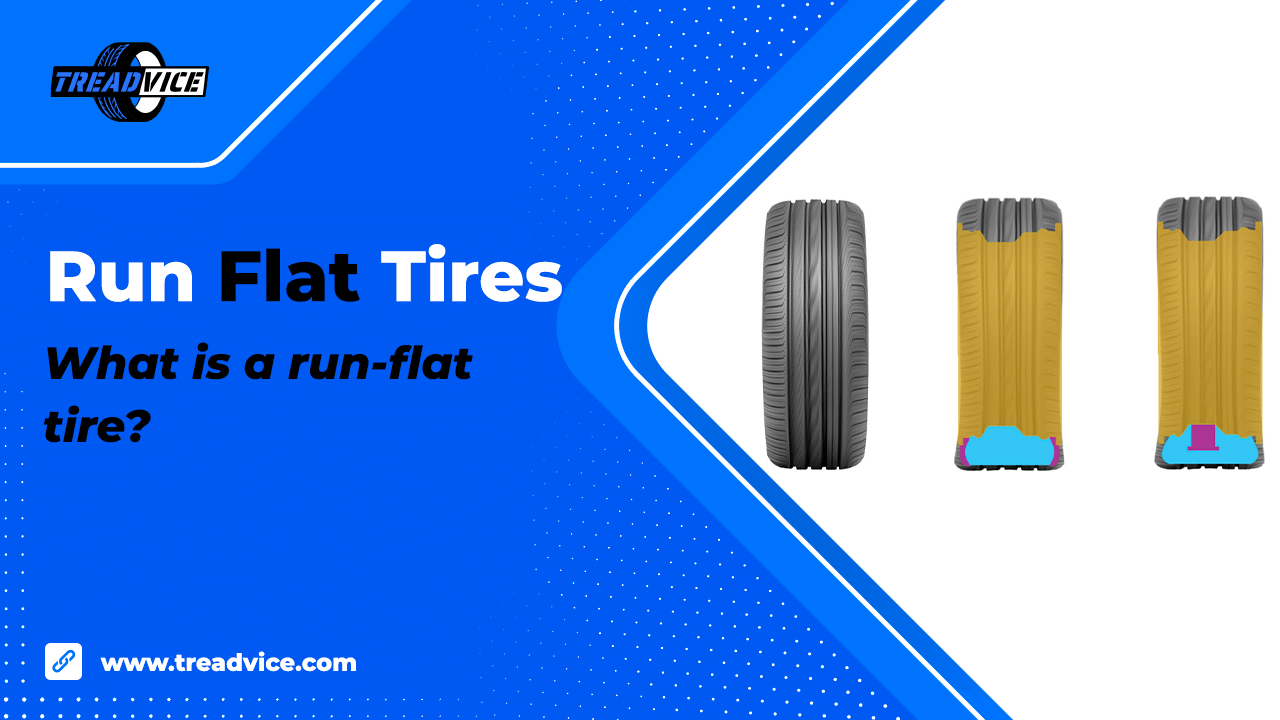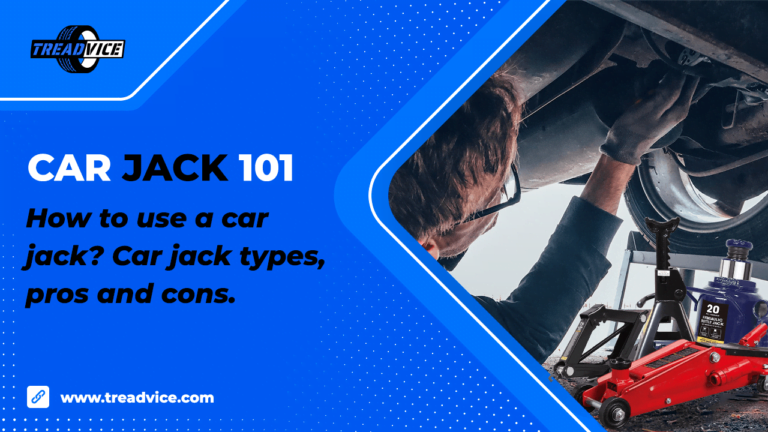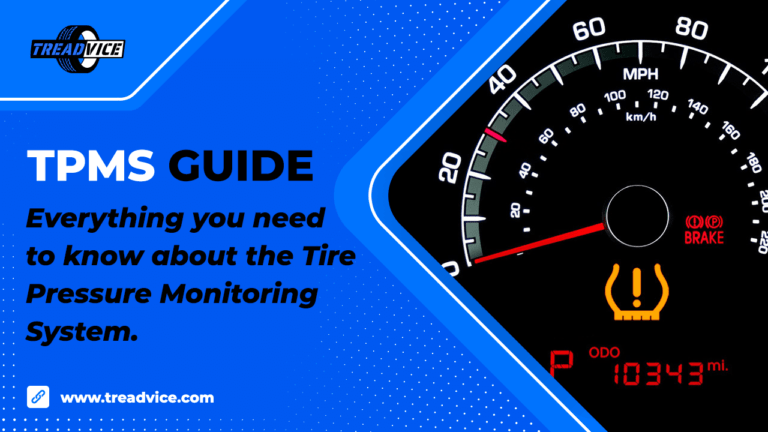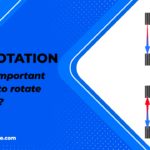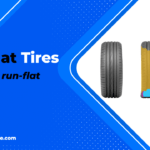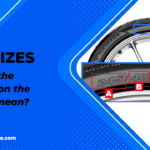Imagine the following situation: you find yourself in a thrilling chase with the police, heart pounding as you navigate the winding streets. Suddenly, you hear the sound of sirens closing in, and adrenaline surges through your veins. With quick reflexes, you make a daring turn, narrowly escaping their pursuit. But fate has a twist in store for you. As you speed away, a nail on the road punctures your tire. Panic sets in, but then you remember—you have run flat tires. With a sigh of relief, you continue your escape, as your reliable run-flat tires allow you to stay in control and outsmart the cops. Well, this is only one of the situations, where a run-flat tire could save the day, but hopefully you won’t get in a situation like this. 😉
In this article, we’ll discuss different topics about run flat tires, understanding their importance, how they work, and exploring the different types available. So fasten your seatbelts and let’s get started!
Table of Contents
What Is a Run Flat Tire?
A run flat tire is a specialized tire type designed to allow you to keep driving safely, even when the tire loses air pressure due to punctures or other issues. Unlike conventional tires, run flat tires have reinforced sidewalls that provide structural support, allowing you to continue your journey for a limited distance, typically at reduced speeds.So it’s crucial to understand that run flat tires still have limitations in terms of driving distance and speed after a puncture, but in most cases these limits are enough to reach a safe location for repair or replacement.
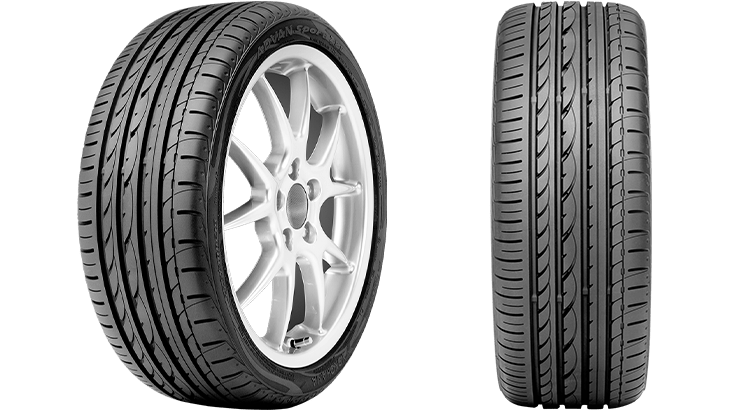
Illustration: Run flat tire – Yokohama ADVAN Sport® ZPS
How Do Run Flat Tires Work?
Run flat tires utilize innovative technologies to ensure they can withstand the loss of air pressure. One common approach is the self-supporting system, where the tire’s sidewalls are reinforced with robust materials. In the event of a puncture, the reinforced sidewalls bear the vehicle’s weight, preventing the tire from collapsing.
The support ring system is another method employed by run flat tires. These tires feature a sturdy ring embedded within the tire, providing support in case of air loss. The ring takes on the weight of the vehicle, allowing you to continue driving until you reach a safe destination.
Another intriguing technology is self-sealing tires. These tires incorporate a special compound or gel-like substance within the tire structure, which instantly seals punctures upon occurrence. The self-sealing mechanism helps prevent air loss and enables you to continue your journey without interruptions.
Types of Run-Flat Tires
The purpose of all run-flat tires are the same, but the way they do it can be different. Let’s see the most popular run-flat tire types:
Self-supporting system
The self-supporting system is one of the most common types of run flat tires. These tires have reinforced sidewalls, typically made of sturdy materials like rubber or composite compounds. When a puncture occurs, the sidewalls support the vehicle’s weight, allowing you to drive for a limited distance at a reduced speed. Self-supporting run flat tires offer the advantage of convenience and safety, as they provide extra time to find a suitable place for tire repair or replacement.
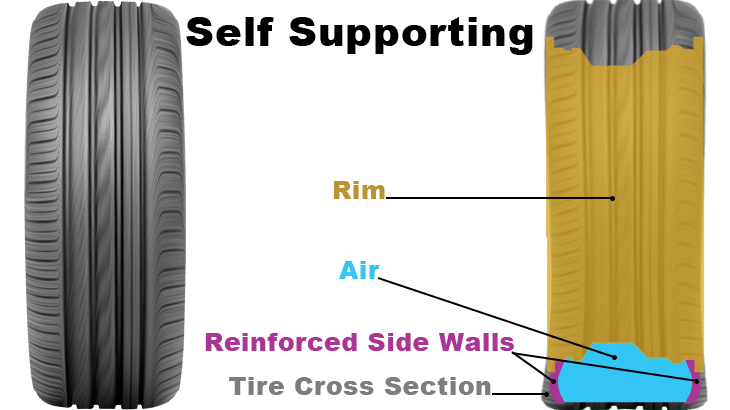
Illustration: Run flat tire – Self supporting construction
Self-sealing tires
Self-sealing run flat tires are equipped with a unique technology that automatically seals punctures as they happen. These tires contain a sealant compound or gel that immediately fills the hole created by the puncture, preventing air loss. Self-sealing tires are an excellent option for those seeking added convenience, as they eliminate the need for immediate tire repair or replacement in minor puncture scenarios. However, it’s important to note that larger or more severe punctures may still require professional attention.
Support ring system
Support ring run flat tires feature a supportive ring or insert made of strong materials such as steel or alloy. This ring is positioned either within the tire or on the wheel itself. In the event of a loss of air pressure, the ring bears the weight of the vehicle, ensuring continued mobility for a specific distance. While support ring run flat tires offer excellent stability and durability, it’s essential to note that they require specialized wheels to accommodate the ring.
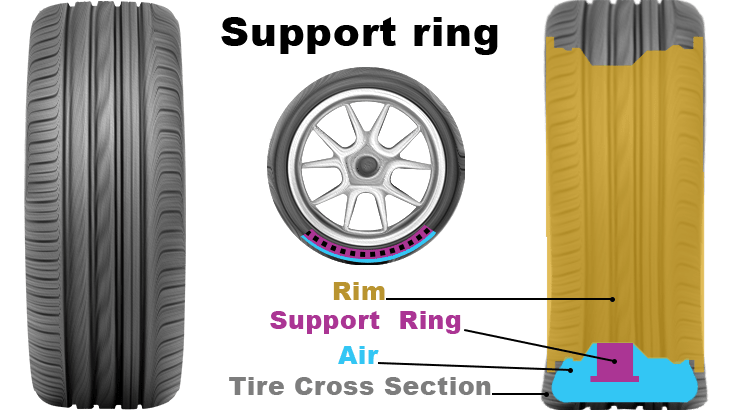
Illustration: Run flat tire – Support ring construction
Advantages and Disadvantages of Run Flat Tires
Like all tires, run flat tires have their own ups and downs. Let’s check some of these.
Advantages
- Safety: These tires provide enhanced safety by allowing you to continue driving, even with a punctured tire. They eliminate the need for an immediate tire change on the roadside, reducing vulnerability and the hassle of spare tire installation.
- Stability: Run flat tires often exhibit better stability and handling characteristics compared to conventional tires, thanks to their reinforced construction.
Disadvantages
- Lifespan: Run flat tires generally have a shorter lifespan than regular tires due to their reinforced design.
- Price: They can also be more expensive to purchase and replace.
- Compatibility: Furthermore, not all vehicles are compatible with run flat tires, so it’s important to check the manufacturer’s recommendations.
- Ride Comfort:
One common concern raised about run flat tires is their impact on ride comfort. Due to their reinforced sidewalls and specialized construction, run flat tires can be slightly stiffer compared to conventional tires. However, tire manufacturers have made significant strides in improving the ride quality of run flat tires.
Advancements in tire design, including the use of advanced materials and improved tread patterns, have resulted in run flat tires that offer a smoother and more comfortable ride. These innovations help to minimize vibrations and noise, providing a driving experience that is comparable to standard tires. Fuel Efficiency: Another aspect to consider when it comes to run flat tires is their impact on fuel efficiency. Due to their reinforced construction, run flat tires can be slightly heavier than regular tires. This added weight can result in a small reduction in fuel efficiency compared to standard tires.
But don’t worry, the difference in fuel consumption is usually minimal and you probably won’t even notice it in day-to-day driving. Advancements in tire technology have helped to mitigate this difference ( just like in case of ride comfort ), with manufacturers continuously working to optimize fuel efficiency in run flat tire designs.
Run flat tire cost considerations
Thinking about investing into run flat tires? Well, it’s important to be aware of the cost considerations involved. Here you can find some factors you should keep in mind:
Initial Cost: Run flat tires generally have a higher upfront cost compared to standard tires. This is because of their specialized design, reinforced sidewalls, and advanced technologies that allow them to run even after a puncture. The added materials and manufacturing processes contribute to the higher price tag.
Replacement Cost: In the event of a significant puncture or tire damage, run flat tires may need to be replaced rather than repaired. Depending on the tire brand, size, and vehicle compatibility, the cost of replacing a run flat tire can be higher than that of a regular tire. It’s essential to consider this potential expense when budgeting for your vehicle’s maintenance.
Limited Repair Options: Run flat tires often have limitations when it comes to repairability. While some minor punctures can be patched or repaired, larger or more severe damage may require complete tire replacement. This means that if a run flat tire sustains irreparable damage, you’ll need to factor in the cost of a new tire rather than a simple repair.
Extended Mobility Features: The advanced technology and added safety benefits of run flat tires contribute to their cost. The ability to continue driving for a limited distance after a puncture, the reinforced sidewalls, and other features that enhance stability and performance come at a price. These added benefits are part of what makes run flat tires an attractive option for many drivers.
Potential Savings: While run flat tires may have higher upfront and replacement costs, they can potentially save you money in the long run. Since run flat tires allow you to drive to a safe location after a puncture, you may avoid the immediate need for a tow truck or roadside assistance, which could be costly. Additionally, run flat tires can provide peace of mind by minimizing the risk of being stranded in unsafe locations or adverse weather conditions.
Ultimately, the cost of run flat tires should be considered in conjunction with the added safety, convenience, and peace of mind they offer. It’s important to weigh these factors against your specific needs and budget to determine if the benefits of run flat tires justify the higher cost for you.
Frequently Asked Questions (FAQs)
Whether a run flat tire can be patched depends on the manufacturer and the extent and location of the damage. For example, in case of the Goodyear run flats, minor punctures, such as those caused by small nails or screws, can often be repaired by qualified tire experts ( but some other manufacturers like Pirelli advise against repairing run flat tires. ). Larger or more severe damage, damage in the side wall, require the tire to be replaced in all cases.
On the other hand, repairability also depends on the specific type of run flat tire. Self-sealing tires, for example, automatically seal small punctures, reducing the need for immediate repair. However, it’s still essential to have any punctured run flat tire inspected and repaired or replaced as soon as possible to maintain optimal performance and safety.
Yes, run flat tires are compatible with tire pressure monitoring systems (TPMS). In fact, TPMS is particularly useful when it comes to run flat tires because it helps monitor the tire pressure and provides early warnings in case of pressure loss. TPMS sensors are installed in the wheels and continuously monitor the tire pressure, sending real-time information to the vehicle’s dashboard or a dedicated display.
Manufacturers have tailored run flat tires to suit various driving conditions and weather elements, providing better traction and control on wet or snowy roads. When it comes to winter driving, run flat tires offer distinct advantages. Their reinforced construction and ability to maintain mobility even in the event of a puncture make them a reliable option for snowy and icy conditions.
Run flat tires designed for winter driving feature specialized tread patterns that enhance traction on slippery surfaces. These tires provide better grip and control, allowing you to navigate winter roads with confidence. However, it’s important to note that even with run flat tires, it’s crucial to drive cautiously and adapt to changing weather conditions for maximum safety.
If you get a nail or similar object lodged in a run flat tire, the tire’s reinforced sidewalls allow you to continue driving for a limited distance. This feature gives you time to reach a safe location for repair or replacement. However, it’s essential to drive cautiously and at reduced speeds to minimize further damage to the tire.
Visually, run flat tires appear similar to conventional tires. However, they feature reinforced sidewalls that are designed to support the weight of the vehicle even when the tire loses air pressure due to a puncture. These reinforced sidewalls are often thicker and stiffer than those of regular tires.
The distance you can drive on a run flat tire after a puncture varies depending on the tire manufacturer and specific model. Generally, run flat tires allow you to drive for approximately 50 miles at a reduced speed of around 50 mph. However, it’s crucial to refer to the manufacturer’s guidelines and recommendations for the specific run flat tire you have installed on your vehicle.
The lifespan of a run flat tire is similar to that of a regular tire. However, run flat tires may have a slightly shorter lifespan due to their reinforced construction. On average, run flat tires can last between 25,000 to 50,000 miles, depending on factors such as driving habits, road conditions, and proper maintenance.
Determining the best run flat tire depends on various factors, including your vehicle type, driving preferences, and specific needs. But there are some reputable tire manufacturers which offer high-quality run flat tires, including Michelin, Bridgestone, Continental, and Pirelli, but there are some other good manufacturers as well!
While it’s technically possible to mix run flat tires with standard tires, it’s generally not recommended. Run flat tires are designed to work optimally within a specific system that includes the vehicle’s suspension, handling characteristics, and safety features. Mixing run flat tires with standard tires can disrupt the balance and compromise the intended performance and safety features of the vehicle. It’s best to consult with the vehicle manufacturer or a tire professional to determine the most suitable tire configuration for your specific vehicle.
A non-run flat tire, also known as a conventional tire, does not have the reinforced sidewalls found in run flat tires. In the event of a puncture, a non-run flat tire will lose air pressure and require immediate repair or replacement. These tires are the traditional type commonly used in most vehicles.
Detecting a flat run flat tire is similar to identifying a flat conventional tire. Common signs include a noticeable decrease in vehicle handling and stability, a change in steering response, and a feeling of imbalance or vibration while driving. Additionally, you may hear unusual noises such as thumping or flapping sounds.
Run flat tires are revolutionizing the driving experience by providing an extra layer of safety and convenience. Understanding their working principles, types, advantages, and considerations can help you make an informed decision for your vehicle. Whether it’s the self-supporting system, support ring system, or self-sealing technology, run flat tires offer peace of mind on the road. So, why not consider equipping your vehicle with these innovative tires and enjoy the benefits of enhanced safety and continued mobility!
Some final words: to maximize the performance and lifespan of your run flat tires, they also need regular maintenance just like standard tires do ( e.g.: rotating the tires and keeping the tire pressure at safe levels ).
